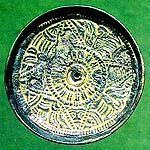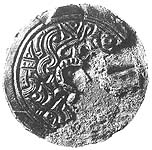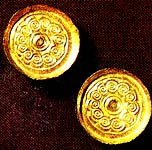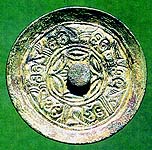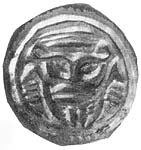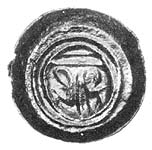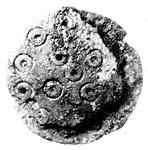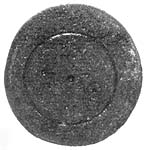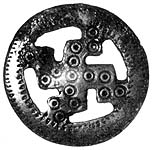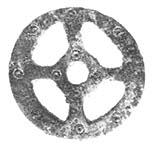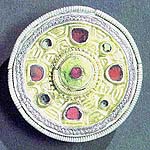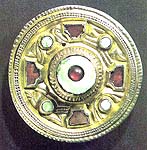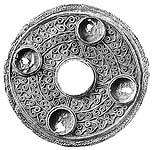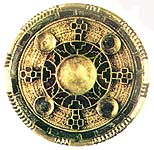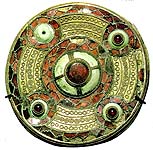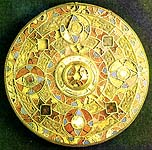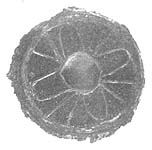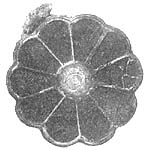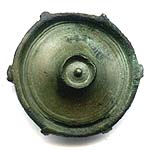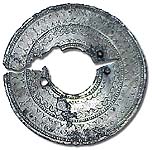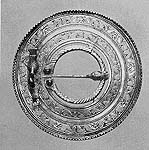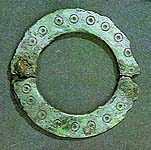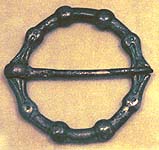 |
||||||||||||||||||||||||||||
|
Lesson #5: Page 2
Applied Brooches
The term ‘applied brooch’ draws particular attention to the fact that the decoration here is neither cast nor chased on to the interior, but is applied ready-made as an embossed disc of copper-alloy foil, usually gilt. These discs are fixed in place with solder, seemingly applied as a thin coating to the back-plate and re-melted with the foil held in close contact. Several other constructional features distinguish these from the comparatively well made saucer brooches. While a few of the back-plates have integral rims in the manner of saucer brooches, and a few are of cast construction, the majority are of sheet metal, made as composite structures with rims that have been produced as separate units and soldered into place. The back-plates may be flat, but many are dished to some extent. Most of the separately made rims are produced as thin strips of sheet metal whose ends are soldered together before assembly. A few are overlapped, occasionally riveted, and in a few cases these plates are formed as an extension of the back plate itself. Normally they adopt a slightly flaring profile, but some are arranged at right angles to the back plate. Many of these rims have now become detached or are absent altogether, but it seems likely that all applied brooches were originally fitted with them to protect the edges of the delicate foil. Cast fastenings are understandably absent on these sheet metal brooches. Most commonly the hinge and catch are each produced from a thin strip of metal, inserted through a slot cut in the back-plate and held in place by bending over the ends. Some of these appear to be secured with solder; this may derive from the same coating of solder applied inside the brooch to fix the foil. Breakages seem to have been common, and since the presence of the foil made it difficult or impossible to insert replacement fastenings through the back, these were commonly soldered on the outside; other such soldered fastenings are undoubtedly original. Fastening pins were normally of iron, but occasionally examples in copper-alloy are found, perhaps representing repairs. The decorative foils were first embossed with their ornamental schemes by impressing them with a prepared matrix. Since many identical foils could have been produced from a single matrix, it is to be expected that many surviving pairs of brooches will have closely matched foils, and this is indeed the case. A number of them have central holes which in some cases still retain a centrally mounted glass cabochon or a decorative bronze stud.. On the Continent the type developed in the late fourth century, particularly in the North German province between the Elbe and Weser. In England those from Dorchester are likely to be among the earliest examples yet recorded, dating to the last decade of the fourth century or early decades of the fifth. Others, often with Style I zoomorphic ornament, are firmly of sixth century origin. click on image for larger version in new window
Usage: Pairs at women’s shoulders
Saucer Brooches
Decoration is confined to the flattened central area, while the rim is left plain. Identical ornament on some pairs of brooches clearly indicates that they have originated from the same mould, or at least the same model. Occurrences of variations in detail are more common than exact identity, however, and these carry implications which are important, though at times difficult to interpret, in the detailed assessment of the methods of production involved. In some cases the cast decorative scheme is complemented by punched ornament. Running spirals seem to form the most common ornament, followed by stars, with a variety of other schemes occurring less often. Most saucer brooches are gilt on the front; on some examples the gilding survives imperfectly or not at all, but XRF analysis suggests that originally all of them may have been gilt. Saucer brooches belong mainly to the fifth and sixth centuries, although some production survived into the early decades of the seventh century. click on image for larger version in new window
Usage: Pairs at women’s shoulders
Button Brooches
Although commonly stylized, many of the represented features provide insights into contemporary fashions in the wearing of hair, moustaches, etc. The type is distributed throughout most of southern England, and in date generally belong to the fifth and sixth centuries. click on image for larger version in new window
Usage: Varies, bur generally in women’s
dress.
Disc Brooches
Little variation can be detected in technique of manufacture. All are made of copper alloy, with the vast majority being simple discs cast with an integral hinge and catch on the reverse. Double hinges are occasionally encountered and in several instances the catches are markedly elongated – an early fifth century feature when encountered on the more closely datable saucer brooches. The pins fastening disc brooches are almost invariably of iron. A very few are of composite construction, having a sheet metal back plate with an applied plate carrying the decoration and with inserted fastenings, all in the manner of applied brooches. Almost all the decoration found on these brooches is scribed or stamped on the surface after casting; the only exceptions may be the broad concentric grooves found on a few brooches. Incised concentric circles and ring-and-dot motifs account for most of the patterns encountered, frequently complimented by concentric patterns of smaller punch marks – annulets, crescents (usually produced with an annular stamp held at an angle), triangles, and V- or S-stamps. A central dot forms a common feature, no doubt representing the axis around which a scriber has been rotated; in some instances the dot is markedly deep and often the brooch is completely perforated at the centre. Not infrequently the periphery of the brooch is notched. Tinning is common on these brooches (especially on the more highly decorated examples), but gilding is not encountered, adding to the impression that they occupy a position complementary to that of the saucer and applied brooches of the more affluent sections of Saxon society (and corresponding to the position occupied by annular brooches in Anglian areas). There are no obvious Continental prototypes for these brooches, which seem to have been an insular Anglo-Saxon development. As a whole the type tends to occur south of a line from the Severn to The Wash. Within this region the upper Thames valley is particularly productive and may have formed a major production centre. Their date range spans the fifth and 6th centuries (mainly the mid-fifth to mid-sixth century), with little evidence for formal development within that period. click on image for larger version in new window
Usage: Pairs at women’s shoulders
Openwork Disc Brooches
click on image for larger version in new window
Usage: Pairs at women’s shoulders
Jewelled (Kentish)
Disc Brooches or Keystone Brooches
The thin slips of garnet mounted on these brooches were produced by splitting the parent crystal along its natural planes of cleavage by means of thermal or physical shock, by polishing the surfaces, and by shaping the garnets with an abrasive stone, possibly in the form of a wheel. It seems likely that, for the most part, they were imported ready-made from Frankish workshops. The garnet settings are usually backed by foils, invariably of gold where they can be examined, stamped repeatedly with overall patterns of dots to form a hatched effect; in some instances it can be seen that groups of dots have been produced by the teeth of a single gridded punch. It appears that the foils were produced as sheets, punched overall before being cut to size. Stamps of wood or bone have been suggested as being particularly suitable for this purpose; during attempts to replicate the effect experimentally, ivory was found to perform well. The white material in brooches of this type has been subjected to analysis, but without conclusive result although shell seems likely. click on image for larger version in new window
Usage: Pairs vertically one above the
other at women’s chests
Jewelled Disc Brooches
of Applied Plate Type
Jewelled inlays, most often of foil-backed garnets but occasionally of glass, are set in cloisons arranged in bands or individual cells. The intervening areas of the front-plates of these brooches are filled with filigree decoration, usually arranged in concentric bands. Although found occasionally in other areas, this type is again primarily Kentish. click on image for larger version in new window
Usage: Singly, or in pairs vertically
one above the other at women’s chests
Jewelled Composite
Disc Brooches
The back plates of these brooches are generally of base silver. In some examples the visible back plate is apparently riveted to an inner copper alloy plate. The front- and back-plates are brought together in the form of a sandwich, with the centre formed by a layer of lime plaster; the plaster both unites the thin plates and separates them to form a more substantial structure (some of the biggest of these brooches are 1cm thick at the rim). Rivets passing from the front-plate to the back-plate add rigidity to some brooches, whilst a separate rim of gold or gilt copper-alloy binds the whole structure together. Garnet and glass settings backed by hatched foils form the common decoration on the front. Calcitic material in some cloisons may have formed both packing and adhesive, but other cloisons were deliberately inset with white as part of the decorative scheme. The larger settings or bosses enclosed in circular cells may have been of shell, as in the keystone brooches. The inset gold panels, some with Style II ornament, which alternate with the cells on almost all examples, were also bedded in plaster. Cruciform arrangements are prominent in the ornamental schemes of these brooches, but no Christian connotation should be applied to them. However, they may have formed part of the new Christian style clothing that went with the newly arrived religion. click on image for larger version in new window
Usage: Generally singly at the chest
or shoulder.
Rosette Brooches
They belong to a Frankish type of rosette brooches that have a diameter of 2-3cm and cells filled with foil-backed garnet, pearl, bone or coloured glass. Production of such brooches began in the first quarter of the 6th century and became most common in its second quarter. A few were still being worn in the second half of the same century. Most of those found in England were probably imports. click on image for larger version in new window
Usage: Singly, or in pairs vertically
one above the other at women’s chests
Tutulus brooches
This type of brooch is of Roman origin, generally produced from the late second to fourth century. It was a brooch of simple form with a circular domed body rising to point in centre and with a raised rim around perimeter. click on image for larger version in new window
Usage: Pairs at women’s shoulders
Quoit Brooches
click on image for larger version in new window
Usage: Singly at chest.
Annular Brooches
Apart from differences in the construction of the band, the most significant technological variations are in the form of the slot and of the axis for the pin. The slot may be bounded by a moulded ridge, may have upturned or recurved sides to inhibit the pin from slipping out (corresponding to the pairs of rivets or pin-stops found on the more elaborate quoit brooches), or it may be formed as a simple notch. Many brooches have no notch whatsoever, so that the dress material must have been pulled through the ring in order to be pierced by the pin. The loop of the pin is most commonly anchored through a hole in the band, sometimes elongated by drilling two intersecting perforations. Several of the more substantial cast brooches have an axis formed by a construction in the band. Pins are invariably of iron. In a few cases, particularly with cast examples, little or no trace of the pin remains and there are no obvious points for its attachment. In these cases it is possible the fabric was pulled through the ring then secured with a separate iron pin. Tinning on the front is a common decorative feature. Further decoration is supplied by incised radial lines or punched decoration. When found in situ this type is found exclusively in women’s graves, usually worn in pairs at the shoulders, ranging in date from the later fifth century (when they are rare finds) to the seventh century; the more substantial types seem generally to belong amongst the later brooches. Their distribution is concentrated most heavily in the Anglian territories, but extends as far as the upper Thames valley and from Yorkshire to Kent. click on image for larger version in new window
Usage: Pairs at women’s shoulders
|
||||||||||||||||||||||||||||
| Costume
Classroom is a division of The
Costume Gallery, copyright 1997-2001.
Having problems with this webpage contact: questions@costumeclassroom.com |
||||||||||||||||||||||||||||
